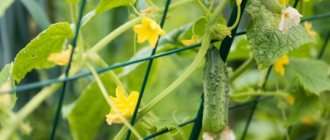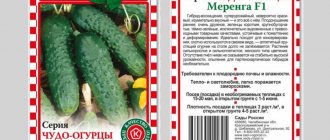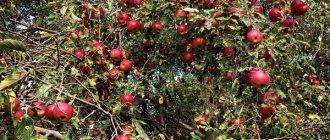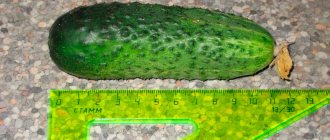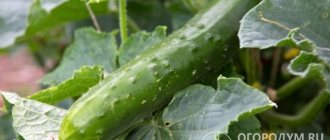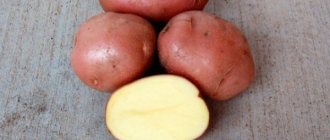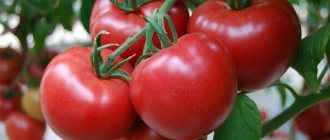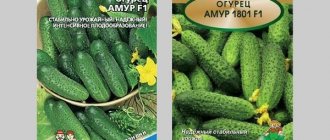History of the variety's creation
The Vnuchok cucumber is a hybrid that was created by a group of breeders led by M. G. Kudryavtsev and E. I. Golovatskaya. These specialists were involved in breeding the variety at the beginning of this century and submitted it for inclusion in the State Register of Russia. The hybrid Vnuchok passed tests and was included in the State Register of the country in 2009.
The cucumber hybrid Vnuchok is recommended for cultivation in open ground and greenhouses in the middle zone and other regions with similar climatic conditions.
Cucumbers Granddaughter F1 - photo
Diseases and pests
Vnuchok cucumbers (F1) are quite disease-resistant. Many gardeners claim that the review variety is not afraid of the main diseases that damage cucumber crops.
The resistance of the hybrid extends to the following diseases:
- Cucumber mosaic virus;
- Powdery mildew;
- Root rot;
- Olive spot.
REFERENCE: Variety Vnuchok (F1) is tolerant to downy mildew.
Pests that may appear on cucumber plantings:
- Spider mite;
- Slugs;
- Aphid.
To protect plants from insects, traditional methods are used: spraying cucumbers with infusions of fragrant herbs and decoctions of various plants. In case of mass invasion of flying pests, special insecticides are used.
Mulching the beds with sawdust, pine needles, and small shell rock will protect the plantings from gastropods.
Cucumber Vnuchok F1: description of the variety
The hybrid Vnuchok belongs to the parthenocarpic type and does not require pollination - the ovaries are formed without the presence of bees. The Vnuchok cucumber is an early ripening cucumber; it takes about 1.5 months from seed germination to harvesting the first greens.
This variety is indeterminate, so its vines have unlimited growth power. Typically the length of the central stem reaches 1.4-1.6 m, but it can grow longer. The top of the lash is pinched when daylight hours are greatly reduced at the end of summer - early autumn, and the temperature also drops significantly.
The lashes do not grow very wide, the number of side shoots in this hybrid is average, and the main fruits are borne on the central shoot. All stems are strong and quite thick. The foliage is typically cucumber, medium in size, dark emerald in color. The flowers are collected in bunches, the color of the petals is yellow.
Characteristics of the variety
“Grandma’s granddaughter f1” refers to indeterminate varieties of cucumbers (the main stem grows unlimitedly). The plant is powerful, the lateral branches grow to a limited extent. Flowering with predominance of female flowers. A bouquet type knot contains 2-4 ovaries. The leaves are dark green, medium in size. Fruit ripening is 40 days from the moment of germination. Other properties of cucumbers “Grandma’s granddaughter f1”:
- length 9-12 cm;
- cylindrical shape;
- fruit weight 100-115 g;
- the color of the fruit is darker at the stalk, lighter at the place where the flower is attached;
- there are light stripes on the skin approximately up to the middle of the fruit;
- fruits are pimply, with many white spines and white pubescence;
- The fruits do not have a seed sac or voids.
Advantages and disadvantages
The main advantages of the Vnuchok cucumber variety include:
- stable long-term fruiting;
- high productivity;
- These cucumbers do not require pollination;
- excellent presentation and good taste of ripe greens;
- even overripe fruits lack bitterness;
- high resistance to diseases;
- the hybrid Granddaughter can be grown in garden beds and in greenhouse conditions;
- This vegetable plant is resistant to adverse weather conditions.
There are no disadvantages noted in this hybrid. But it should be remembered that seeds cannot be collected from this vegetable crop, so they have to be purchased anew every year.
Features of agricultural technology of the variety
The high yield of this variety of cucumbers depends on compliance with the rules of agricultural technology. Grow in two ways:
- seedling;
- direct sowing of seeds into the soil.
The seedling method is used by gardeners living in regions with cool climates. Vegetable growers grow seedlings to get the harvest earlier.
Seeds are planted in prepared containers and boxes in mid-April or early May to a depth of 2 cm. The soil is sprayed with warm water from a spray bottle (a device for spraying liquid into small drops). Temperature for seed germination is +18 ° C.
Important!
The soil should be nutritious and light: a mixture of peat, sand and garden soil is best.
Young plants are transferred to unprotected soil at the end of May. The recommended planting pattern is 50x50cm.
You may be interested in: Favorable days for transplanting cucumbers in open ground Dates for planting cucumbers in May 2021 according to the lunar calendar The most favorable days for planting cucumbers in the Leningrad region according to the calendar of gardeners and gardeners
Care:
- Formation. The shoots are removed, the flowers remain in the axils, the stems and flowers are removed only from the first 5 leaves.
- Hilling. One of the types of soil cultivation. Sprinkling moist, finely lumpy soil onto the roots and base of the stem while simultaneously loosening it.
- Weeding. Removing weeds.
- Watering. To prevent fungal infection, water the soil with warm water every 2-3 days under the plant in the evening. In hot weather, water the plant twice a day - morning and evening.
- Feeding. They use organic matter and minerals - K preparations (potassium), simple mineral phosphorus fertilizer (P), ammonium nitrate mineral fertilizer (NH₄NO₃).
- Foliar irrigation (feeding). This is the application of fertilizers, in which plants receive nutrients through stems and leaves.
- Fixation. They are tied to poles or devices resembling a garter lattice. The bushes must be fixed. Do not allow the stem to be pulled over.
The fruits retain their taste and presentation well in fruit storage facilities (fruit cellars, fruit cellars). The temperature needs to be regulated by ventilation units, the crop is cooled with natural or artificial ice (fruit storage refrigerators). Only healthy fruits are selected for storage. And with damage, bruises, with wormholes and punctures, fungal diseases - they are unsuitable for a long-term illness.
Note!
The fruits are stored on shelves or in boxes, which are arranged in tiers during the winter. Boxes are viewed selectively 1-2 times a month.
The hybrid is resistant to the following diseases:
- Powdery mildew - it is also called ash or white.
- Brown spot (cladosporiosis) is a leaf mold. Caused by microscopic pathogenic fungi.
- Root rot - This is a fungal disease that leads to wilting of the entire plant, affecting the root, root collar, and base of the stem.
- Cucumber mosaic is a viral disease that can lead to illness and destruction of the entire crop.
- Peronosporosis - it is also called: downy mildew. First oily and then brown angular spots appear on the leaves.
The cucumber variety is practically resistant to insect pests.
Planting cucumbers Grandson
It is better to choose beds for this variety of cucumbers in a sunny, fertile area with loose soil that allows moisture and oxygen to pass well to the roots of cultivated plants. Moisture should not accumulate in the soil, otherwise cucumbers may develop root rot. The acidity of the soil should be neutral or slightly alkaline (with a pH of about 6.2). It is advisable that the beds be located on a hill.
The best soils for growing Vnuchok cucumbers are loamy or sandy loam. If the soil on the site is sandy, then humus should be added to it so that moisture does not evaporate from the beds too quickly. Coarse river sand and compost are usually added to heavy soils to make them looser.
Advice!
If the soil is too acidic, then in the fall, when digging, lime, chalk or dolomite flour must be added to it.
When planting the Vnuchok variety in the middle zone and other regions with similar climatic conditions, it is better to prepare warm or high beds so that the crop develops better.
Grandson cucumber seed is planted in open ground approximately 10-12 days after the spring frosts have passed. Since the Vnuchok hybrid is characterized by early ripening of fruits, its seeds can be planted a second time approximately 25-30 days after the first.
In regions with cold summers, it is better to grow the Vnuchok cucumber variety using seedlings.
At the same time, at home, seeds are planted approximately 20 days before transplanting the seedlings to a permanent place.
When the air temperature is above 20 degrees Celsius and the humidity is about 65%, the seed material germinates 4-5 days after planting.
The beds for cucumbers are prepared in advance. Vegetable and other debris is removed from the site, the soil is dug up and loosened. Mix the soil with any organic matter (compost, humus or rotted cow manure). Before planting seed material or seedlings, the beds are watered quite abundantly. A layer of drainage 4-5 cm thick must be laid at the bottom of the planting holes.
Usually two rows of cucumbers are planted in each bed. In this case, the distance between plants in a row should be about 0.3 m, and between adjacent rows in a bed - 0.5 m. The distance between the centers of adjacent beds should be 2 m.
In greenhouse conditions, Vnuchok cucumber seeds are planted from early April to late May. Before planting, the soil must be dug up and disinfected by pouring boiling water or a weak solution of potassium permanganate. When preparing beds in a greenhouse, they must add organic matter, which this vegetable plant loves very much.
Cucumber Adam: description and characteristics of the variety, cultivation features, photos, reviews
The number of varieties and hybrids of cucumbers is huge, and choosing the right one is very difficult. Among the best is Adam F1, which is far from the newest hybrid: it has excellent taste and good yield, it can be grown in any conditions, the first greens appear quickly.
Description of the Adam cucumber, its characteristics, growing region
Adam F1 is a parthenocarpic hybrid obtained in Holland. It is the fruit of the work of the famous seed company BejoZaden BV. This organization is engaged in obtaining new varieties of various vegetable crops. The hybrid came to Russia in 1989, but only in 2002 it was included in the State Register of the Russian Federation and recommended for cultivation in all climatic regions.
Since the Adam F1 cucumber can be planted in open ground, in temporary greenhouses, and in permanent greenhouses, there is no point in limiting the regions where it is grown. It is known both in the south of Stavropol and in the Leningrad region; it is planted by both amateur gardeners and farmers in large agricultural enterprises.
Adam F1 is an early-ripening cucumber; the first fruits are picked 45–52 days after emergence. It has high productivity, up to 10 kg/m2. Indeterminate, but the height of the bush with vertical cultivation is not prohibitive.
It is on the trellis that this variety is usually grown.
To pollinate female flowers, bees and other flying insects are not required, at the same time, the availability of plants for insects does not affect the shape of the fruits and their quality, which explains the possibility of growing the variety in open ground.
The stems are thick, light green, the leaves are small, their color ranges from green to dark green. It is highly resistant to a range of diseases, in particular:
- powdery mildew,
- cucumber mosaic,
- olive spot.
Zelentsy have a rich dark green color, finely tuberculate, with white pubescence. Their length is about 10 cm, diameter is 3–4 cm, weight is about 90 g. The taste of fresh fruits is assessed as very good.
It should be borne in mind that the taste qualities of such parthenocarpic varieties of Dutch selection as Amur 1801, Atik, Yildo, Infinity are rated somewhat higher: they are characterized as excellent.
The fruits of the Adam variety have the usual cucumber aroma and a sweetish aftertaste. In a cool place, the fruits can be stored for up to 2 weeks. Regarding the direction of use, the data in the State Register is contradictory: both salad and canning purposes are indicated, which apparently indicates the universal use of the crop.
Appearance
The appearance of Adam cucumbers differs favorably from varieties that in the recent past were called the offensive word “greenhouse”. Both in shape and color, it meets all the characteristics of a traditional “crispy” cucumber, and the presence of tubercles and pubescence only emphasizes the elegance of this cucumber .
Cucumber Adam is a “classic of the genre” in shape: appetizing both outside and inside
Advantages and disadvantages of a hybrid
The popularity of the Adam F1 cucumber is due to the advantages noted by specialists and amateurs. The positive qualities of a hybrid include:
- good yield;
- early but extended fruiting;
- excellent presentation of greens;
- good taste;
- ability to transport and preserve the crop;
- resistance to major diseases;
- self-pollinating.
The noted characteristics allow us to recommend the hybrid to beginning gardeners. But you should also take into account the disadvantages, of which there are few, for example:
- inability to use seeds from your harvest;
- thin peel, forcing you to handle greens with caution.
The peculiarity of the Adam cucumber is that it feels equally good both in the greenhouse and in the open ground; both the yield and the quality of the fruit practically do not depend on the location . Are there any other cucumbers like this? Of course there is.
The variety of varieties both in the State Register lists and in any store is such that choosing the right one is very difficult; a description of the characteristics of the variety, its cultivation and use, as well as reviews from experienced gardeners, which you should always pay attention to when choosing a variety, can help with this.
There are amateurs who try every year to try out all the new hybrids that come into being, but this is becoming increasingly difficult to do.
There are summer residents who prefer traditional old varieties and receive good harvests from the well-known Nezhinsky, Altaisky, Konkurent, etc. In addition, you can get your own seeds from varieties (not hybrids).
It is difficult to give recommendations on choosing a variety when there are many hundreds of them. It’s probably better to choose a variety “for yourself” by trial and error.
Features of planting and growing cucumber Adam
The agricultural technology of Adam cucumbers differs little from that of most early-ripening varieties of universal use. Both direct sowing of seeds in the ground and cultivation through the seedling stage are possible . In the south, if there is no need to obtain early produce, they do not grow seedlings, and in the northern regions the seedless method is rarely used.
Growing seedlings
Adam cucumber seeds are sowed in cups a month before seedlings are planted in the garden or greenhouse. Planting seedlings in the garden is carried out when the soil temperature is at least 15 ° C, as well as the transition of night air temperatures through 10 ° C. In the middle zone, this is the beginning of June, so sowing seeds for seedlings is carried out no earlier than the end of April.
The timing of sowing seedlings for a greenhouse is determined by the quality of this greenhouse.
Preparation of Adam F1 cucumber seeds, like any hybrid, is not required. If there are puny seeds in the bag, it is better to throw them away. The seeds are not cheap, so they are planted one at a time. The capacity of the cups is at least 250 ml, it is better to take peat pots . If you don’t have the ingredients for your own soil, you can buy it in a store, or you can make it up from peat, turf soil, sawdust, and humus.
Adam cucumber seeds are sown to a depth of 1.5 cm, watered well, covered with glass and placed in a bright place with a temperature of 25–28 °C. After the emergence of seedlings after 5–8 days, the temperature is reduced to 17–18 °C and left at this level for 4–5 days. Subsequently, cultivation is continued at 24 °C during the day and 18 °C at night.
There is no need to try to grow seedlings in a common box: cucumbers are planted in a garden bed, trying not to damage the roots even to the minimum extent
Caring for seedlings is simple: it involves watering and, if the bushes stop growing, one feeding with a solution of complex fertilizer. Shortly before planting in the garden, the seedlings are hardened off by taking them out onto the balcony for a short time.
Planting Adam cucumbers in open ground and greenhouse
Cucumbers need fertile beds; even fresh manure is suitable for fertilization, the dose is 2-3 buckets per 1 m2. The best predecessors are cabbage, legumes and potatoes. In open ground, “warm beds” are often prepared by burying a “cushion” of various organic wastes in the ground in advance.
Adam cucumber seedlings are planted without shelter in the middle zone no earlier than the beginning of summer. The seedlings are removed with a lump of earth and planted without burial. Water well and mulch. Direct sowing of seeds in the garden bed is carried out a week earlier, to a depth of 2.5–3 cm.
Since they try to grow the Adam cucumber on a trellis, dense planting is possible, every 25–30 cm.
Planting seedlings or sowing seeds in a greenhouse is carried out similarly, the timing depends on the quality of the greenhouse: this is done when the required air and soil temperatures are reached. It is convenient to plant the Adam cucumber both at the side wall and opposite the entrance to the greenhouse (in the latter case, 2 rows are planted on both sides of the trellis).
You shouldn’t let Adam cucumber vines fall on the ground: when grown vertically, care is easier and the yield is higher
Caring for cucumbers Adam
In a greenhouse, the yield of this cucumber may be slightly higher, but in open ground, cucumbers are usually tastier. The main concerns are watering, fertilizing, forming vines, and timely harvesting of cucumbers.
Watering is carried out in the evening, with water heated in the sun. The frequency and consumption of water depend on the weather, but the soil should not dry out.
They loosen it only to a shallow depth; the weeds are pulled out by hand.
Adam cucumbers are fed up to 4 times a summer, trying to use organic matter. First, 2 weeks after planting the seedlings, then with the appearance of the first flowers and during the period of intensive fruiting.
When 4–5 leaves appear, the main stem of the Adam cucumber is tied with a soft ribbon to a support, then as it grows. When the height reaches 50 cm, the side shoots are removed.
After the central stem reaches the height of the trellis, it is pinched, and the side stems are pinched: to a height of 1 m above the 3rd leaf, up to 1.5 m above the 4th, up to 2 m above the 5th. You can regulate the load on the plant by removing certain side shoots.
Old lower leaves are torn off as they turn yellow. Gradually, the main fruiting of this hybrid moves up the canes; this is a normal process.
If space allows, indeterminate cucumbers can not be pinched at the top, but canes can be hung from the top wire of the trellis
The harvest must be harvested systematically, preferably every other day: this stimulates the appearance of new cucumbers. They do this early in the morning or late in the evening, helping themselves with pruners or scissors.
Reviews
Cucumber Adam F1 is one of the many beautiful early fruiting cucumbers for universal use. Its undoubted advantage is that it grows well regardless of where it is planted, and caring for it is not difficult.
Source: https://diz-cafe.com/sad-ogorod/ogurec-adam-opisanie-sorta-foto.html
Further care for cucumbers Grandson
In the future, caring for growing cucumber bushes comes down to regular watering, frequent fertilizing, loosening the soil, and removing weeds. It is also necessary to periodically treat the lashes against diseases and pest attacks, despite the high immunity of the Vnuchok hybrid.
Cucumbers should be watered often enough to prevent the soil from drying out, especially during the fruiting period.
But excessive soil moisture should also not be allowed. Cucumber bushes should be watered strictly at the root, avoiding dripping on the foliage, otherwise sunburn may appear in these places.
The soil should be loosened after each watering to remove the dry crust that forms on the soil surface. At the same time, all weeds are removed. After loosening, a layer of mulch is added around the cucumber bushes to prevent rapid evaporation of moisture and intensive growth of weeds. The thickness of such a layer should be about 4 cm.
Since the vines of Vnuchok cucumbers grow quite tall, they should be tied to trellises. The distance between the rows of wire in trellises is usually 25-30 cm, and the height of the trellis is about 1.5 m. When the top of the lash reaches the top of the trellis, it is pinched, thereby activating the growth of side shoots, on which ovaries will also form.
Interesting!
Feeding cucumbers in the open ground with folk remedies for a good harvest
Care
To obtain a good harvest (not only quantity, but also appearance and taste characteristics), it is necessary to observe the following work on caring for cucumbers: watering, fertilizing, loosening the soil and forming bushes. Experts offer a number of recommendations, which are described below.
Watering
The beds with Grandson f1 cucumbers are watered once every 3-4 days (depending on weather conditions). During hot weather, watering work is increased to 1 time every 2 days. The hybrid variety is usually watered with warm water. To do this, the liquid is heated in the sun or on fire. It is recommended to water the crop in the evening after sunset.
During fruiting, cucumbers of the Vnuchok variety must be watered, focusing on soil moisture. During this period, as a rule, up to 20 liters of liquid per 1 m2.
In hot weather, vegetable growers recommend sprinkling. For this process, use a solution of water (1 bucket) and 30 grams of urea. This solution is used to feed the leaves of the plant.
Garter and bush formation
It is recommended to tie cucumbers Granddaughter f1 to a pre-prepared trellis. To do this, it is necessary to cut off the lower lateral processes up to 5 ovaries.
When tying the stems of the Vnuchok variety, you should help them weave in such a way that the cucumbers do not touch the ground. It is also recommended to use vertical or horizontal supports.
Top dressing
During the entire growing season, cucumbers need to be fed 2 times. Cucumbers are usually fertilized with mineral components: urea, potassium nitrate. Experts advise initially feeding the soil with mineral fertilizers, and then with organic fertilizers: manure, humus, manure, or nettle infusion.
Hilling
This crop does not require hilling. However, they loosen it with a pitchfork. This agrotechnical procedure allows you to provide the root system of Vnuchok f1 cucumbers with water and oxygen, as well as get rid of weeds.
Top dressing
The first feeding of the Vnuchok cucumber variety is done when the plants bloom.
Usually complex mineral fertilizers are taken, in which nitrogen, phosphorus and potassium are in equal proportions. Nitrogen fertilizer promotes active growth and development of green mass of vines. Potassium improves intercellular nutrient exchange. And phosphorus is “responsible” for the growth of the root system and the active formation of ovaries.
Feeding cucumbers
25-30 days after the first feeding, these fertilizers are re-applied.
Care and agrotechnical advice
“Grandma’s granddaughter f1” needs to be formed and fixed. In the axils of the first 5 leaves, the stems and flowers are removed, then only the shoots are removed. Plants need to be tied to trellises, otherwise the vines will spread along the ground, causing part of the potential harvest to be lost. Flowers and ovaries will fall off from lack of light, and already formed fruits will rot. The plant is tied up when its height is 32-35 cm.
This variety, like other cucumbers, needs watering, hilling, weeding and fertilizing. Water the plants once every 2-3 days with settled water heated to + 22 °C. Watering is carried out at the root in the evening. In extreme heat, cucumbers are watered twice a day - morning and evening. After watering, the plants are earthed up - the wet soil is loosened, sprinkled onto the roots. Weeds are weeded once a week.
Fertilizing is done 3-4 times per season. Mineral fertilizers with potassium, phosphorus, as well as ammonium nitrate fertilizer are applied under the roots. Organic fertilizers are also used, for example, mullein diluted in water. Foliar feeding is also used, especially in cold summers. For it, a spray bottle is used, with which a solution of nutrients is sprayed onto the leaves (this should be done when there is no wind or rain, so that the fertilizing does not blow away or wash away). Most often, urea is used for foliar feeding (10 g diluted in 10 liters of water). Seedlings that have just been planted in the ground are sprayed with it, then spraying is repeated after 15-20 days.
To prevent diseases, you need to inspect the leaves and stems of plants daily. If black or gray spots, gnawed by insects or wilted leaves are found, the cucumbers will have to be treated with disinfectants such as Fitosporin.
The fruits of “Grandma’s granddaughter f1” are collected daily or every other day so that they do not overgrow, and it is advised not to pick them, but to cut them with a sharp knife. The harvest continues until the end of July. When fruiting ends, the cucumber stems are removed and the soil is fertilized.
Cucumbers Vnuchok F1: reviews from those who planted
Olga, 45 years old, Volgograd region: We grow cucumbers specifically for sale. Therefore, a lot of space has been allocated in the garden for this vegetable crop. For a long time we were looking for early-ripening, productive varieties of cucumbers that could be planted several times a season. Finally we settled on the hybrid Vnuchok. We liked this early-ripening and productive variety due to its friendly germination of seed material, active growth and good productivity. The taste of ripe greens is sweetish, while Vnuchok cucumbers are crispy and aromatic.
Maria, 45 years old, Moscow region: This is not the first season we have been growing the Vnuchok cucumber variety, as it is distinguished by early ripening of the crop, good presentation and taste of gherkins, and the ability to use them not only for food, but also for preservation. The main positive quality of ripe fruits is the absence of bitterness even when overripe.
Advantages and minor disadvantages
Among the advantages of cucumber are:
- Juiciness, excellent taste characteristics, no bitter aftertaste.
- Long period of fruit production.
- Good transportability over long distances.
- Strong immune protection against diseases to which non-hybrid cucumbers are susceptible.
- Short period between planting seeds and fruiting.
- Productivity that increases when planted in a greenhouse.
- Wide range of ways to use.
The disadvantages include:
- the lack of seed material characteristic of all hybrids;
- If the harvest is untimely, the skin of the fruit becomes too hard.
